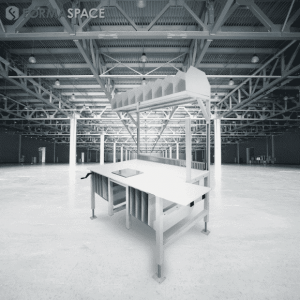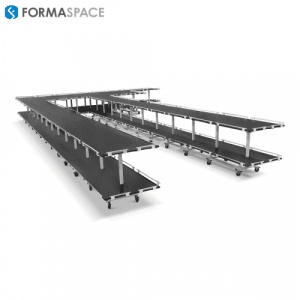Can the Newly Passed Infrastructure Bill Solve Our Ttransportation Bottlenecks?
Find out how the roughly $500 billion allocated to transportation improvements through Infrastructure Investment and Jobs Act (IIJA) will affect you.
If you were to judge the extent of American transportation bottlenecks by the speed of Amazon package deliveries – with millions of items available for delivery to your doorstep in a few days or in some cases just a few hours – you might come away thinking we are in a golden age of delivery logistics.
But to achieve this remarkable “Best of Times” experience, Amazon has made unprecedented investments in its transportation logistics infrastructure. Since ramping up its delivery operations in 2014, Amazon has delivered over 10 billion packages – with 72% of them shipped via Amazon’s far-flung network, which now boasts:
400,000 Amazon Drivers
40,000 Amazon Semi Trucks
30,000 Amazon Vans
500+ Amazon Logistics Facilities
70 Amazon Cargo Planes
$1.5 billion dedicated Amazon Air Hub at Cincinnati/Northern Kentucky International Airport
Most recently, Amazon has sought to bypass the cargo shipping container backlog by chartering its own cargo ships.
Only a few retail giants (Walmart, Home Depot, Costco come to mind) can compete, but even these companies can’t match the full spectrum of Amazon’s infrastructure investment ambitions (which now includes shipping non-Amazon orders to compete with FedEx and UPS on its network.)
So where does that leave everyone else?
For Those Relying On America’s Deteriorating Infrastructure, It Is The “Worst Of Times.”
America’s crumbling transportation infrastructure can best be described as an underfunded Dickensian poor house. Most of us have to endure the brunt of transportation delays on a daily basis – from overcrowded, potholed highways and gridlocked city streets that tear up vehicle tires and suspensions at an alarming rate – to the very real possibility that highway overpasses and bridges you commute to work or send your kids to school on will collapse unexpectedly.
The result is a cascading effect that is exacerbating the ongoing supply chain crisis – leading to problems such as the unprecedented delays in US Post Office first class mail delivery – all of which add up to significant pain points for individuals and businesses trying to conduct everyday transactions.
Why Is The American Transportation Network Falling Apart?
Several factors are coming together at once to create a crisis situation in the American transportation network, including:
· Structures Outliving Their Useful Life
Much of American infrastructure has outlived the “useful life” set forth by the original civil engineers and transportation designers who built them. For example, the first of New York City’s subways opened in 1904, and even “modern” transit systems, such as San Francisco Bay Area’s space-age BART (opened in 1972) and Washington DC’s Metro (opened in 1976), have or will soon be 50 years old. Likewise, interstate highways dating back to the start of the Eisenhower-era Federal-Aid Highway Act of 1956 (which kicked off the interstate highway building boom) are approaching their seventh decade in service.
· Population Growth / Shifting Demographics
The US population has grown significantly since much of our transportation network was planned and constructed – keep in mind that in 1950 there were only 150 million of us, but the 2020 census now counts nearly 330 Americans, a 220% increase. Adding to the problem, Sunbelt metros have grown rapidly at the expense of northern cities. For example, in 1950, Philadelphia and Detroit were the third and fifth largest cities, while Houston was 14th and Phoenix was 99th! Today, Houston is fourth, and Phoenix has shot up to fifth place. Overall population growth strains our existing transportation infrastructure, but the fast-growing regions, which tend to rely more heavily on car and truck traffic to move people and goods around, are especially hard hit.
· Supply Chain Trading Patterns
Trading patterns have also changed dramatically since much of our infrastructure was first designed. As rapid delivery has taken hold thanks to the e-commerce revolution, airports have had to expand cargo capacity, leading to the rise of dedicated cargo terminals for UPS, FedEx, and now Amazon to bypass crowded public airports. And since so many goods are now produced overseas, our coastal ports are under stress to handle the massive amounts of the now ubiquitous intermodal cargo containers (which, by the way, were still in development in the mid-1950s and only standardized in 1970). Finally, many of our nation’s east coast ports are also still playing catch up – needing to dredge deep water channels to handle the new class of Panamax cargo ships that pass thru the Panama Canal’s new wider and longer lock and channel system.
· The Effects Of Climate Change And Need For Disaster Preparation
Transportation systems are also increasingly at risk due to higher ocean water levels, stronger hurricanes, and more intense rainfall (east of the Rockies), which have over the years washed out railway lines and forced closures of major highway networks. Out west, record high temperatures have caused highways and bridges to buckle, while wildfires and smoke have shut down highways for days at a time. Finally, a better understanding of seismic conditions up and down the West Coast has increased the urgency of retrofitting or replacing structures vulnerable to seismic shaking.
Importance Of The Newly Passed Infrastructure Investment And Jobs Act (IIJA)
Since 2020, Amazon has invested nearly $74 billion in capital expenses, largely to build out its logistics network, in an effort that analysts say will help the company double its delivery volume by 2025.
Meanwhile, government infrastructure spending has been shrinking.
According to the Brookings Institute, overall Federal, state, and local infrastructure spending actually fell by $10 billion (in inflation-adjusted dollars) during the ten years between 2007 and 2017, dropping from $450.4 billion in 2007 to $440.5 billion in 2017.
But it gets worse. Remember, that’s the topline government spending number. The actual amount of spending dedicated to transportation infrastructure (including roads, bridges, rail, transit, aviation, and ports/waterways) was only 68% of the topline spending number – and it dropped from $303 billion in 2007 to $298 billion in 2017. Furthermore, the Federal government’s funding share within the mix dropped during this period, leaving state and local funding sources to pick up the slack in an effort to help get transportation projects moving again.
For argument’s sake, let’s mix apples and oranges for a second and compare Amazon’s recent $74 billion capital expenses spending with the topline Federal, state, and local infrastructure budget of $440 billion (in 2017). A back-of-the-napkin calculation shows Amazon’s recent capital spending is roughly 17% of the government’s 2017 annual spending on infrastructure.
This means Amazon is either spending far too much or the government is spending far too little. Since Amazon packages can be delivered overnight, and our transportation system is hugely out-of-date, common sense would say government spending hasn’t kept up.
That’s why the new Infrastructure Investment and Jobs Act (IIJA) is such important legislation – it will help fund an additional $500 billion for roads, bridges, highways, mass transit systems, and railroads.
Is it enough?
Read more...
Julia Solodovnikova
Formaspace
+1 800-251-1505
email us here
Visit us on social media:
Facebook
Twitter
LinkedIn
Legal Disclaimer:
EIN Presswire provides this news content "as is" without warranty of any kind. We do not accept any responsibility or liability for the accuracy, content, images, videos, licenses, completeness, legality, or reliability of the information contained in this article. If you have any complaints or copyright issues related to this article, kindly contact the author above.


